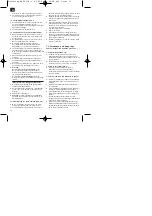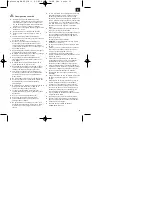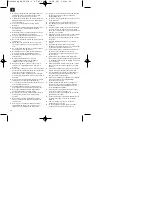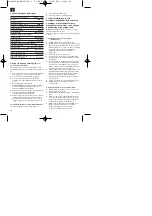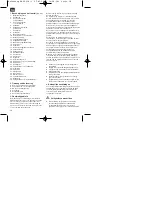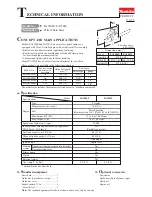
19
on the rear side of the saw with 2 screws each,
as illustrated in Fig. 11.
6.2 Converting the combination saw
The saw has two working positions:
A: Bench-type circular saw (Fig. 1)
B: Cross-cut and mitre box saw (Fig. 2)
To convert the saw from one working
position to another, proceed step by
step exactly as described below or you
may damage components.
Caution: Pull out the power plug each time
before you convert the saw!
The saw is delivered in working position A (bench-
type circular saw).
6.2.1 Converting the saw to mitre box mode
앬
First slacken the locking nut (15).
앬
Raise the saw table (16) with the one hand while
pressing down the machine head by the handle
(2) with the other.
The blade (5) must disappear completely in the
slot of the saw table (16).
앬
Re-tighten the locking nut (15).
앬
The locking fork (24) has lifted as the result and
released the retaining pin (23).
앬
Press down the machine head by the handle (2)
and pull out the retaining pin (23).
This disconnects the power supply to the switch
(4) for bench-type circular saw mode and
connects it to the switch (3) for mitre box saw
mode.
앬
Caution!
A return spring causes the machine
head to rise automatically at the end of the cut.
Do not let go of the handle (2) as soon as the cut
is completed but steady the machine head and
allow it to rise slowly.
앬
Remove the saw blade cover (14).
앬
The saw is now ready for use in mitre box saw
mode.
6.2.2 Converting the saw to bench-type circular
saw mode
앬
Set the machine head in vertical position and the
rotary table (8) to 0°.
앬
Fix the locking screws (10) and the clamping
screw (22).
앬
Place the lower saw blade cover (14) on the
rotary table (8), making sure that the two rear feet
of the cover latch securely behind the
stop rail(7).
앬
Press the release button (1) and lower the
machine head by the handle (2) until the lower
saw blade guard (14) completely covers the
blade.
앬
Insert the retaining pin (23) in order to fix the saw
in the lower position. This also redirects the
power supply from switch (3) to switch (4).
앬
Undo the locking nut (15) and lower the saw table
(16) to the required cutting depth.
앬
Re-fix the locking nut (15).
앬
When the saw table (16) is lowered it blocks the
retaining pin (23) with the locking fork (24) so that
the pin cannot be pulled out.
앬
The saw is now ready for use again in bench-
type circular saw mode.
7. Operation
(Fig. 1-9)
After every change of setting we recommend that
you make a test cut in order to check the new
dimensions.
Important: Your machine is equipped with an
overload switch (b) (Fig. 17). The machine shuts
down automatically when overloaded. You must
wait a few minutes for the machine to cool before
restarting. Then press the overload switch (b)
again and the machine is ready for use.
7.1 Using as a bench-type circular saw
Convert the saw to bench-type circular saw mode
(see 6.2.2.). Be careful when starting the cut.
7.1.1 On/Off switch (Fig. 4)
앬
To switch on the saw, press the green button (a).
Wait for the blade to reach its maximum speed
before starting the cut.
앬
To switch off the saw, press the red button (b).
7.1.2 Adjusting the cutting depth (Fig. 2)
앬
Slacken the locking nut (15) and move the saw
table (16) to the required sawing depth.
The blade (5) should project a few mm out of the
workpiece.
앬
Re-fix the locking nut (15).
7.1.3 Making longitudinal cuts (slitting) (Fig. 4)
앬
Undo the knurled screw (25) and set the cross
and parallel stop (18) to 90°. Re-fix the screw
(25).
앬
Insert the parallel stop (18) from the right into the
front slot of the saw table (16).
앬
Undo the two knurled screws (26). Slide the stop
rail (27) forward to a pint above the middle of the
blade (5) and fix in place.
GB
Anleitung KGST 210-1 25.05.2005 14:20 Uhr Seite 19








